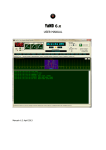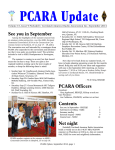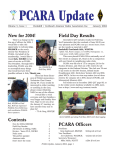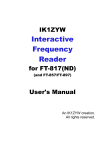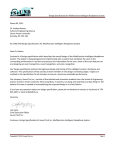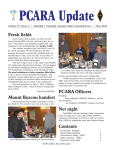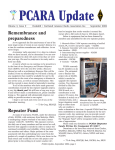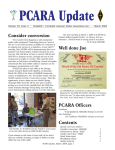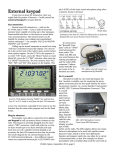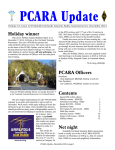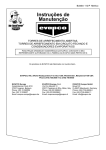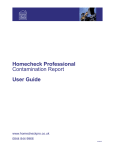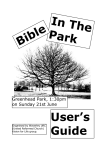Download Clean out time - KB2CQE Holiday Dinner PCARA Officers Contents
Transcript
PCARA Update Volume 13, Issue 1 Peekskill / Cortlandt Amateur Radio Association Inc. Clean out time - KB2CQE The Fifth Annual PCARA Bring and Buy Auction will be held on January 8, 2012 monthly meeting at Hudson Valley Hospital Center. If you’re like many Hams, you just might have a few extra pieces of equipment lying around the shack. Take a few minutes and place some of those treasures into a box and bring them with you to the January meeting. You just may end up with a few more dollars in your pocket and give someone else an opportunity to enjoy those items - just think of it as a way of recycling. January 2012 ary 8, 2012 meeting (3:00 pm) at Hudson Valley Hospital Center in Cortlandt Manor, NY. I look forward to seeing each of you there. -73 de Greg, KB2CQE Holiday Dinner The photo below shows PCARA members with their families enjoying the annual Holiday Dinner, held “At the Reef” restaurant on Sunday December 4. More photos can be found on page 11. PCARA Officers President: Greg Appleyard, KB2CQE, kb2cqe at arrl.net Vice President: Joe Calabrese, WA2MCR; wa2mcr at arrl.net Contents Kevin N2KZE (right) looks on as auctioneer NM9J offers a desirable item at a previous PCARA bring and buy auction. The beginning of a new year is a great time to plan on what we would like to accomplish as an organization in the upcoming months of 2012. Bring your thoughts, ideas, and suggestions with you to the Janu- Clean out time - KB2CQE Adventures in DXing - N2KZ TV memories - NM9J Holiday dinner Bring and Buy auction Postal rate rise PCARA Update, January 2012, page 1 1 2 5 11 11 11 Adventures in DXing - N2KZ O Canada The second largest country in the world, home to 35 million people, is just north of the United States. Most of us know so very little about it. As omnipresent as it may be, Canada is a mystery to most of us. Outside of stereotypes of Mounties riding horseback in red uniforms, hockey players and vast lands of snow and igloos, Americans are often blind when looking north. I have discovered Canada! I have become fascinated with our neighbor and its cultures. Although dominated by British and French influences, aboriginal people have lived here for thousands and thousands of years. Their heritage is rich and quite varied, composed of many different tribes each holding a legacy all their own. Include everything Canada’s worldwide immigrant population has added and you’ll find a cornucopia just as diverse as America’s but with a personality all its own. Canadian broadcast media offers so many interesting alternatives to what we regularly watch and listen to in the fifty states. Three English-speaking networks dominate television offerings for Anglos: the publicly-funded CBC, Bell Globemedia’s CTV and Global. All three present a combination of Canadian and American shows. CBC peppers its schedule with British material, as well, such as Coronation Street. The advent of the Internet and streaming video has made access to Canadian TV and radio easier than ever before. Americans would enjoy a refreshing sample of the Canadian point-of-view. Canadian news broadcasts seriously consider not only events in Canada and America but the entire world. Entertainment programming is just as fresh. Would you ever expect to see a show called ‘Little Mosque on the Prairie’ on American TV? You wouldn’t believe how entertaining and eyeopening this one show has become up north. critical acclaim, earned huge audiences and became the most popular show on Canadian TV. It’s all about a woman in her thirties, (played by Alberta-native Erin Karpluk,) who finds herself a therapist with the ability to send her back into her past allowing her to change everything she regrets. The writing is fresh and Being Erica’s Erin Karpluk intellectual and does not depend on violence and intrigue to be entertaining. Distributed worldwide by the BBC, a second incarnation of ‘Being Erica’ is now in development as a new show for ABC-TV stateside. If you can’t wait, the first three CBC seasons are available free on demand at hulu.com. Three Canadian news shows are worthy of your review: CTV presents ‘Canada AM,’ a three hour news magazine seen on-line at: http://www.ctv.ca/ canadaAMPlayer/index.html in beautiful 16x9 HDTV quality. Be sure to also check ‘Jeff’s Videos’ for some amazing footage found on the Internet. Be aware that the weather reports include temperature readings in Jeff Hutcheson with “Canada AM” weather - in degrees C. Little Mosque on the Prairie Another Canadian gem is the dramedy ‘Being Erica’ that recently completed its fourth and final season on the CBC. Set in Toronto, the show received centigrade. It’s not that cold up there! The hard news CTV National News with Lisa LaFlamme is also worthy of your attention at: http://www.ctv.ca/ctvnews/. CBC’s ‘The National’ is a daily hour-long gem with thoughtful analysis and discussion anchored by Peter Mansbridge. A truncated 10 minute version is available on iTunes. CBC Radio offers a nearly endless supply of programming for every taste. Use Internet Explorer and PCARA Update, January 2012, page 2 go to: http://www.cbc.ca/radio/#. Click ‘See what is playing on all live streams’ and it will reveal dozens of different program choices being broadcast to distinct regional areas all over Canada. CBC Radio podcasts are easily available via iTunes or at: http://www.cbc.ca/ podcasting/. You could spend years sampling the hundreds of different programs they offer. It’s quite a course in all things Canadian! One Canadian radio show has also captured my fancy. CBC Radio’s ‘Q’ with Jian Ghomeshi is a nationwide phenomenon covering the world of entertainment, arts and culture. Jian’s well-produced and fast-paced show attracts the biggest names in show biz. You’ll delight following his ability to create insightful interviews and commentary that surpass most everything I have ever heard. Many memorable Jian Gomeshi live performances season his already delightful show. ‘Q’ is now being distributed in the United States via Public Radio International and can be heard on WNLK-AM 1350 Norwalk, CT at noon and 7pm weekdays. Free audio and video podcasts of his material can be found on iTunes and on the show’s web site: http://www.cbc.ca/ q. CBC’s Radio One is available 24/7 on Sirius satellite radio channel 159. My favorite of all media from up north is the independent channel known as NTV from St. John’s, Newfoundland. Here you will see what life is like in Newfoundland and Labrador in a homemade style all their own. A low-powered TV station outside of Tampa, Florida rebroadcasts NTV for all the ‘snowbirds’ who vacation down there. In turn, the Tampa station can be seen via the Internet at wpso.com. Three times a day you can see NTV newscasts: 7 to 8:30 am, 10:30 to 11 am and 4:30 to 5 pm. There is also much more to be seen on demand at www.ntv.ca. If you are a certified TV DXer, you can see NTV directly via e-skip on analog channel 4! If you are looking for something fresh and new or just seeking a new perspective, take a gander at all Canada has to offer. There is so much to see and hear and it’s all free and on-demand. Take a look! You may find some wonderful and entertaining shows that you never knew existed. It’s all waiting for you and just a mouse click away. Pass the Molson, eh? Get the Message? The messages are being sent all day - every day. You just have to decode them! If you are looking to experiment with something new, try NAVTEX. Navigational Teletext is broadcast by the U.S. Coast Guard and similar entities around the world. You’ll find them primarily on 518 kHz just below the AM broadcast band. With a good antenna and ground system, these broadcasts are claimed to be useful out to about 400 miles away even during the daytime. Typical transmitter power is up to 1000 watts daytime and about 300 watts or so at night. With a good antenna and ground system, your nighttime reception can be worldwide! US Coast Guard Navtex transmitters for Atlantic seaboard Here’s some great news: You can set up your receiver, connect it to your computer and just walk away! Using free software, such as YaND (Yet another NAVTEX Decoder) you can log station after station and then review your results hours or even days later. You’ll have an instant record of your reception on-screen and there will be little doubt what you have received. The NAVTEX protocol is very similar to amateur radio’s AMTOR. The format is properly known as SITOR Mode B and is broadcast at a rate of 100 baud. It’s also commonly referred to as ‘Narrow Band Direct Printing Telegraphy’ especially considering that professional NAVTEX receivers churn out long pieces of paper with the sent messages inscribed. Commoners, like us lowly DXers, use computers instead! Using my modest worldband portable radio, a Sony ICF-SW7600GR, hooked up to a trusty laptop, I have achieved some great results! All you need is one simple audio patch cord. Connect your radio directly to your computer’s sound card and you should be all set. My very first reception showed all the details of mari- PCARA Update, January 2012, page 3 time advisories for the Caribbean! A multitude of stations each take turns periodically during the day on 518 kHz until the cycle is repeated again. One big challenge is to receive stations based in far off places like Greenland and Newfoundland. For best results, you need a long antenna along with an efficient ground system. I had fine results just using the built-in ferrite bar antenna in my Sony. Tuning in is easy: Although the broadcasts are on 518 kHz, tune to 516 kHz using upper sideband and tune up about 1710 Hz for a good lock. You’ll see your current offset on-screen with your NAVTEX decoder software. Look for the two distinct peaks. You’ll likely have to adjust the level of the audio and the frequency a bit to lock in the text broadcasts with best efficiency. YaND also features a tab allowing you to walk in your phase relationship to enhance reception further. Although there are lots of different NAVTEX decoding programs for your trials, the best one I have found is YaND available at: http:// www.yand.wavetalk.org/. Look for up-to-the-minute information about the discoveries of other NAVTEX DXers at: http://groups.yahoo.com/group/navtexdx/. Make sure you also have a good guide to station identifiers and broadcast schedules so you’ll know when to listen and how to decode the messages: http:// www.ndblist.info/navtex/navguide.pdf written by Alan Gale, G4TMV. For a comprehensive list of every NAVTEX station and their schedules, take a look at Bill Hepburn’s amazing list at: http://www.dxinfocentre.com/ navtex.htm. You’ll find that we are in Navarea IV which includes the United States, Canada, Bermuda and Greenland. Wouldn’t it be neat to log an unmanned station from the Kook Islands off Greenland? Look at Bill’s list to see when to tune in! If you operate PSK31, you’ll be right at home logging NAVTEX with YaND softYAND software for decoding ware. It Navtex transmissions. features a similar waterfall display and many useful tools to fine-tune your reception of this data. Watching the text come in can be very exciting while you wait for a station ID verifying your reception. Last night, I logged a long string of text detailing how marine vessels should stay clear of helicopters on maneuvers during a scheduled training exercise. New and unusual? You bet! Give it a try! 30 Meter Beacon Beckons It is highly unusual to hear a beacon on a WARC band, but a new one is attracting a lot of attention. From the southwestern corner of the Show-Me state in Highlandville, Al, W0ERE is on the air with a QRP CW beacon for all to hear. The heart of Al’s beacon is a MFJ 9030 rig, at three watts, hooked up to a G5RV antenna. Look for it on 10.12925 MHz with an endless loop message in Morse. W0ERE/B beacon transmitter uses an MFJ-9030 30 meter CW transceiver. W0ERE/B easily made it to my Sony ICFSW7900GR portable worldband radio one morning. I emailed Al and cheered him on! Now that I know it’s there, I notice it with great regularity at my QTH. I was very surprised to hear CW that high up since most regular 30 meter CW activity takes place way below 10.125 MHz. The upper half of the 30 meter band is usually occupied by more complex digital modes like RTTY and PSK-31. Take a listen for Al’s beacon. It makes a great QRP CW catch! Tuna Tin II It never ceases to amaze me just how low you can go with power and still be heard with just a straight key, a handful of AA batteries and two transistors mounted into a tuna can! I had not used my Tuna Tin II in quite some time, so I fired it up one recent Saturday morning looking for adventure on 7040 kHz. The batteries did not dip in voltage when I began to transmit with its blazing 250 milliwatts of power derived from two 2N2222’s into my 40 meter dipole hanging over my garage roof. I heard an immediate response from Bob, K2OGT down in Centereach on Long Island’s north shore. To him, I was just another signal! My signal report was a PCARA Update, January 2012, page 4 steady RST 559 and we had a good long chat. K2OGT has been around since 1957 and I had a lot of questions about the good old days. Bob rewarded me with a vintage QSL card he had used as a Karl’s Tuna Tin II QRP transmitter. novice operator 54 years ago! It’s amazing how far you can go with just a cat food can! Holy Day A quick reminder: The CW annual holy day of obligation, ARRL Straight Key Night, will be on the air from 7pm Saturday night, December 31 through Sunday, January 1 at 7pm. SKN is a informal contest event where hams dust off their vintage gear and operate with straight keys (no electronic keyers!) for a day to remember how it was long ago. Many, many operators who are not usually on CW will be participating (along with all the regular CW ops) sending nice slow code with their seasoned fists. This is a great opportunity to try Morse code on the air. Everyone will be sending slow code and this is what everyone expects to hear! It’s great fun and an interesting time will be had by all! If you are shy about CW, just tune in. The unusual sound of the old transmitters just might inspire you to try the most ancient of modes! Start the New Year right and listen for me! CQ SKN DE N2KZ... Start the New Year right: Our Facebook page is continually updated with interesting news and tips. Just type ‘PCARA Facebook’ into a browser and you’ll be there in no time. Entertaining and fun, our weekly Old Goats Net is always looking for new participants and listeners. Tune in to the PCARA 2 meter repeater (146.67 MHz) at 8pm Thursday nights. Keep in touch by reading PCARA Update and tell your friends about it. An amazing archive of all our newsletters from the past ten years is available at pcara.org. Encourage your friends to get on the air. Even better, encourage friends to become hams too! Enjoy every minute! Happy New Year! 73 es dit dit de N2KZ. TV memories I was looking for an old-style computer monitor. Those old, 4:3 ratio monitors were much better for reading documents — but they have almost disappeared. Over a period of a few short years we have moved away from cathode ray tube monitors with the old 4:3 ratio to flat panel LCD displays with the widescreen format, for both computer screens and television. And so another piece of useful technology that served us well for over 60 years has been cast into the trash pile of history. This started me thinking back to my own encounters with analog TV technology, going back all the way to the 1950s. First encounters My first exposure to television would have been in the early 1950s in the suburbs of Manchester, UK. This particular memory is a bit hazy owing to my tender years, but it would have been around 1953. The British Broadcasting Corporation’s pioneering TV efforts began at Alexandra Palace, London in the 1930s. After World War II, the BBC expanded television transmitter coverage across the UK. The Sutton Coldfield transmitter came on air in 1949, covering Birmingham and the Midlands. In my part of the world, northern England, we had to wait until October 1951 for the BBC’s TV transmitter to come on air from Holme Moss, high in the Pennine hills between Lancashire and Yorkshire. The Coronation of Queen Elizabeth II in June 1953 gave a great boost to Television. It was the transition from a service for the rich and technically savvy to a domes- Alexandra Palace in north London began regular television tic appliance suitable transmissions in November 1936. for everyone’s home. The antenna consisted of vertical My uncle was one of wires stretched between the the first in the street to horizontal arms visible in the own a TV set, so that’s picture. PCARA Update, January 2012, page 5 how I came to be in his house, along with my younger cousin, for the televised Coronation ceremony on June 2, 1953. Direct from Ally Pally It’s worth remembering the technology of the time — the 405 line TV standard used in Britain dated from November 1936 when EMI’s technical team commenced VHF broadcasts for the BBC from Alexandra Palace in north London, alongside the competing 240 line Baird system. John Logie Baird’s system was based on static cameras with EMI’s television system was all-electronic mechaniwith mobile cameras. cal scanning and an intermediate film process, while EMI’s system was all-electronic, based on vacuum tubes, with small “Emitron” cameras that could move around the studio floor. It only took a few months for the authorities to decide that EMI’s 405line system was technically superior and the way to go. The new service continued for three years until transmissions from “Ally Pally” were closed down in 1939 for World War II. They were resumed with the same technical standards — and the same program — in 1946. The seventy fifth anniversary of BBC TV transmissions was just a few months ago in November 2011. At Holme Moss, transmissions were from an antenna 750 feet above the wild Yorkshire moors. Early TV transmissions used the low VHF band, and Holme Moss employed UK channel Holme Moss TV mast 2, with the vision carrier on stood 750 feet above the 51.75 MHz and AM sound Yorkshire Moors, 1720 on 48.25 MHz, vertically feet agl. polarized. Early plans had called for a 900 MHz microwave link to feed the video signal from London to Birmingham and points north, but the microwave system could not meet specifications for two-way communication, so the Post Office employed underground coaxial cables of 1" diameter to feed from London to Birmingham and 3/8" diameter cable to feed onward to Holme Moss. As domestic TV sets began to be installed in northern England, a mixture of “H” and “X” antennas began sprouting from rooftops in “X” and “H” antennas above the roofline. order to receive the VHF signal from Holme Moss. The H antenna was a vertically polarized two-element Yagi, but the “X” antenna was a different design by Antiference called the “Antex”. In this arrangement, three of the four elements were connected to the outer braid of the coaxial cable, while one element was connected to the inner conductor. This antenna is not widely known outside the UK, but it was analyzed by the late L. Cebik, W4RNL (http://www.cebik.com). He showed that the “X-array” antenna has a forward gain of around 6dBi and a front to back ratio of 10dB or better on 50 MHz. This was helpful for reduction of video ghosts caused by reflections from hills and other buildings. My family’s first TV set arrived around 1955 and was a console model, housed in a beautiful wooden cabinet. It received Channel 2 from Holme Moss — and that was it! One channel, BBC Television and no other choices available. The signal from Baird 17" console Holme Moss on low-VHF traveled a long way and could be received throughout northern England, North Wales and across the Irish Sea as far as the Isle of Man and parts of Ireland. Those large antennas on the roof for low-VHF were quite vulnerable. I can remember watching TV as a youngster one wild night in Southport when the screen went blank. A few minutes later there was a PCARA Update, January 2012, page 6 Coverage area of BBC Televison from Holme Moss. knocking at the door, and our next door neighbor was standing there asking — “is this yours?” He was holding our giant size VHF X antenna that had just fallen from the roof into his yard. Declaration of independence BBC Television was paid for by an annual license fee and carried no advertising. That monopoly situation changed in 1955-56 when Independent Television (ITV) came on-air. The BBC was using all five of the low-band VHF TV channels 1-5 for national coverage, so ITV was broadcast on the high-band VHF channels, known as Band III. The service for northwest England came from a 450 foot tower atop a 1400 foot moor near Bolton, Lancashire known as Winter Hill. The ITV transmitter was on Channel 9 — vision carrier 194.75 MHz and sound on 191.25 MHz AM. During weekdays, ITV programs came from Granada Television’s studio in Manchester. Unfortunately there were still huge numbers of recently-purchased single channel low-VHF sets (like my family’s) that were incapable of receiving the new service. The solution was to fit a “converter” within the wooden cabinet. The converter took the antenna input into a vacuum tube RF stage and mixer that converted the high VHF signal down to the low-VHF input of the TV set. Home visits from TV engineers to fit converters were widespread. I remember a cartoon showing a housekeeper opening the rectory door to a TV engineer and saying to the member of the clergy within: “the man’s come to convert you, vicar”. New TV sets soon appeared with built-in “turret tuners” that could receive low-VHF channels 1-5 for BBC TV and the high-VHF channels 6-13 for ITV. The turret tuner was a click-stop device that rotated a separate set of tuned coils and capacitors for each channel into the vacuum tube RF amplifier and mixer/ oscillator stages. The RF stage was likely to be a Mullard PCC84 dual triode in a cascode circuit, folMullard PCC84 lowed by a Mullard PCF80 triode/ double triode pentode with triode oscillator and was designed for pentode mixer. The local oscillator VHF cascode was free-running and had a rotary operation. fine-tuning control for precise adjustment. TV sets of the time needed a certain amount of expertise, with multiple controls brought out to the front and rear panel, including vertical and horizontal hold, contrast, brightness, channel control and fine tuning as well as the volume on/off knob. Although the 100 kW ERP Winter Hill transmitter was putting out a strong, vertically polarized signal, the vacuum tube tuners of the time were not particularly sensitive. The shorter wavelength around 1.5 meters allowed gain antennas to be added to the roof tops and the indication of a multi-channel TV in the household was the presence of a multielement Yagi on the rooftop for ITV, joining the much larger lowVHF antenna for BBC. VHF coverage X antenna for low-VHF with It’s interesting to note that 5 element Yagi for high-VHF. while the BBC could provide a TV service for both sides of the Pennine Hills from a single low-VHF transmitter at Holme Moss on channel 2, ITV needed two transmitters at Winter Hill in Lancashire and at Emley Moor in Yorkshire — to cover a similar area at high-VHF. High-VHF television provided better reception than low-VHF. Interference from nearby spark plugs, electric motors and hospital diathermy equipment was far less disruptive on high-VHF than on the lower VHF frequencies. As other European countries introduced their own TV service during the 1950s and 1960s, another problem came to light with Band I low-VHF. During periods of extended Sporadic-E propagation, strong signals on 41-66 MHz could be received for hours on end from stations that were hundreds of miles away. In my part of northern England, where channel 2 PCARA Update, January 2012, page 7 was in wide use, there was strong interference during the summer months from a 250kW transmitter 900 miles away in Madrid, Spain. The European frequency plan was slightly different from the UK’s, but Madrid’s E2 vision carrier was co-channel with the sound carrier from Holme Moss, resulting in an annoying heterodyne on top of the sound. The BBC came up with a solution — in 1964 they introduced a high-VHF transmission of BBC1 Television for northwest England from Winter Hill on Channel High-VHF coverage from Winter Hill. 12, 209.75 (This was for BBC1 on Ch 12.) MHz video carrier, vertically polarized, 125 kW erp. This second outlet provided an opportunity for regional programming for northwest England from the Manchester TV studio (which I’ve visited), while regional programs for the Yorkshire side of the Pennines were produced in Leeds for continuing broadcast on Channel 2 from Holme Moss. Three TV networks By the mid-1960s, low VHF channels 1-5 and high-VHF channels 6-13 were being fully used to provide two 405-line TV services — BBC and ITV — across the United Kingdom. The next development required a shift to higher frequencies and some new techniques. The BBC opened its second television network “BBC2” in April 1964 using UHF transmission on the European standard of 625 lines. Sound modulation was changed from AM for the old 405line system to FM, using 6 MHz intercarrier sound in the receiver. The vision modulation sense was changed from positive-going for the old 405 line system (where noise appeared as bright sparkles) to negative-going, so that noise appeared as darker spots. In northwest England, the Independent Television site at Winter Hill was used for BBC2 UHF transmissions. During 1964-65 a brand new tubular steel mast “New” 1015 ft tubular steel mast at Winter Hill is at right. The white sections on top are fiberglass shrouds for the UHF and VHF TV antennas. Shorter masts at left were used for Post Office microwave links and police/fire radio. was erected with a height of 1015 feet. The hilly terrain on the west side of the Pennine Hills required a greater mast height and many more relay stations for UHF coverage than had ever been needed for VHF. BBC2 television came on air from Winter Hill in 1965 with an ERP of 500 kW on channel 62, horizontally polarized. The vision carrier was on 799.25 MHz and FM sound was 6 MHz higher, on 805.25 MHz. I remember seeing BBC2 television for the first time that year at an amateur radio convention in Belle Vue, Manchester. Those new standards for BBC2 television needed a fresh generation of TV sets. I remember that the new TV in my family’s home was a so-called “dual standard” vacuum tube set. This had separate tuners for VHF and UHF, plus an IF strip that had a long wafer switch running its entire length. The “system switch” used for changing from 405 lines to 625 lines selected the UHF tuner, changed the 38 Baird 661 dual-standard 405-625 line monochrome TV MHz IF from positive to negative video, and changed the sound demodulator from AM to 6MHz intercarrier FM. It also had to change the line-output stage’s frequency from 10.125 kHz to to 15.625 kHz. As you can imagine, the front panel 405/625 button required a mighty push to accomplish all this. Dual standard sets were never very reliable. The use of vacuum tubes for UHF TV reception had its problems too. Receiver sensitivity at 800 MHz PCARA Update, January 2012, page 8 was not very good, and the small Yagi antenna bolted to the VHF antenna mast and aimed at Winter Hill did not pick up much signal. The receiver’s local oscillator was free-running, so BBC2’s channel 62 had to be tuned manually. Band-V UHF propagation was less reliable than high VHF, so the signal could be affected by nearby buildings as well as leaves on trees. While I was living in Southport, there was an area in the shadow of the local gasworks which was adversely affected by the Southport gasholders. ‘gasometers’. This was not helped when a new 300 foot high gasholder was erected in 1969 – and only recently demolished. The family’s early dual-standard set also affected my short wave listening. The 6 MHz intercarrier FM sound circuitry was not well shielded, and radiated a powerful harmonic on 12 MHz that covered up a chunk of the 25 meter short wave broadcast band. I complained about this, but the visiting TV engineer said I would just have to live with it. With all these technical problems and somewhat “high-brow” program content, BBC2 Television was slow to become popular. In the late 1960’s TV set design improved, with transistorized tuners and station selection using pushbuttons, controlling varicap diodes through rotary potentiometers. One of my favorite transistors from those days was the Mullard BF180, a silicon NPN-type used as the low-noise RF stage in thousands of BF180 VHF/UHF TV tuners, and in several of my own converters for VHF and UHF amateur radio reception. The coming of color Color television arrived — on BBC2 UHF 625-lines initially — in 1967. The BBC adopted the PAL (phase alternate line) color standard, in line with most of Europe apart from France and Russia. I can remember seeing the first programming in a Southport store — the green grass of Wimbledon tennis on BBC2. Later on I remember seeing “Laugh-In” in color at a Cambridge college. Color television in the 1960s was an expensive proposition, with only the most well-off families able to afford the large, expensive sets, which still needed to be dualstandard in order to pick up 405-line monochrome BBC1 and ITV. In November 1969, the two 405 line services of BBC1 and ITV television were duplicated on UHF, in 625 lines color. In Northwest England, BBC1 was on channel 55 (743.25 MHz) and ITV was on channel 59 from Winter Hill. The broadcasters moved their 625-to405 line standards converters from the studios to the transmitter sites overnight and the distribution system changed over to 625 lines. The availability of all three national TV services on UHF 625-line color started the UK’s great color TV boom of the early 1970s. Since there was no need for VHF 405-line reception, the UK TV sets only needed a UHF tuner, and a single standard IF strip, reducing costs. Color reception still required a large, heavy shadow-mask cathode ray tube, but improvements in design meant that sets were not as deep and heavy as in the early days. My family’s first color TV was memorable because by then I was earning a living and contributed to its £212.00 purchase price in 1974. (That figure was around ten week’s income!) The set was a 22" Pye CT205 using the 697 single-standard hybrid chassis with solid state tuner, IF strip, sound and color decoder. Only the line output (sweep tube), HV rectiPye CT20x series, singlefier, luminance and standard color TV. chrominance outputs used vacuum tubes. I kept a complete set of tubes instock at home so I could service the set myself — and I still have the Service Manual. Twenty two years later, that set was still running well, during one of my visits to Southport. With the low signal levels, UHF television needed a higher grade of coaxial cable than on VHF, and UK manufacturers provided a suitable product at reasonable cost. The standard 75 ohm UHF coaxial cable had a 5/16" outer diameter with a foam polyethylene dielectric. Belling-Lee coaxial connectors with an aluminum body and soldered center pin became standard for TV and FM radio. Radio amateurs used the same UK 75 ohm low-loss high-quality cable and connec- coaxial cable fitted with tor for HF, VHF and UHF a Belling-Lee connector. transmitters until SO-239 and PL-259 connectors became standard in the 1970s. Since all three UK TV channels could now be received on a single UHF antenna pointed at Winter Hill, there was no longer any need for the old VHF X, H and Yagi antennas. Many of these had weathered badly PCARA Update, January 2012, page 9 and were taken down or fell down. I made good use of some of these old antennas, which had been made with heavy duty aluminum, cutting them down to size for 2 meter and 4 meter antennas. Changing times The color TV boom of 1973 saw the beginning of the end for UKproduced television sets. UK manufacturers such as Bush, Pye, Baird, Thorn-EMI, and Marconi could not produce G3VNQ full wave vertical for 2 meters enough sets to satisfy demand was made from cut-down VHF TV antennas. (That’s Southport Football and models with unfamiliar names Club in the background.) had to be imported from Europe. In the late 1970s and early 1980s, sets from Japan and the Far East began to appear at unbeatable prices, with high reliability. Not only did this spell the end of domestic TV manufacturing in Britain, it also saw a decline in the need for trained TV engineers – those mobile marvels who would visit people in their homes to fix faults and align the shadow-mask picture tubes. From my earliest days in amateur radio, I remember that many radio club members were professional TV engineers who kept the nation’s TV sets running from a little service van with a selection of popular vacuum tubes stowed in the back. I learned a great deal from those skilled technicians about converging color tubes and fault finding on a “live chassis” with UK 240 volt AC mains and 300 volts DC never far away. Farewell 405, hello six In the mid 1980s, a chapter in UK TV history closed. For around fifteen years, all the new TV sets had been UHF 625-lines only, so the old 405 line monochrome services on VHF were being watched by fewer and fewer people. I remember at the time that Bury Radio Society paid a visit to the ITA transmitter site at Emley Moor in Yorkshire. Emley Moor was an unusual site because the tubular steel mast erected in 1964 for UHF television had collapsed in 1969 due to heavy icing. It had to be replaced by a more rugged, concrete tower. The engineers in the control room told us they were no longer monitoring the output from Emley Moor’s VHF Channel 10 transmitter and relied on a lady viewer in the depths of a Yorkshire valley who phoned them whenever there was a problem. The smaller 405 line relay stations were switched off during 1984. Then on January 1-2 1985, the remaining 405 line transmitters were all switched off for the last time. A few people in isolated spots had difficulty with reception, but the BBC and ITV continued building UHF relay stations to fill in the low-lying valleys and shadow areas. Meanwhile UK radio amateurs were getting ready Emley Moor TV transmitter site in for a new era in VHF. The six Yorkshire has a meter band had been a no-go 1084 foot concrete area for decades in Europe tower. because of Channel 2 television. But during the run-down of 405-line TV services, a small number of UK amateurs — 40 to begin with, then 100 — had been given special permits to operate on 6 meters outside normal television hours. Then, on February 1 1986 a permanent allocation at 50 - 50.5 MHz was made available by the Department of Trade and Industry for use by all UK “Class A” licensees, with a few restrictions. Despite purchasing a 6 meter transverter While in the UK, I acquired a 6 meter module for module for the Yaesu FTV-901R. use with my FT-902, this development came just two weeks too late for me — because by mid-January 1986, I had been transferred from the Manchester area to the Chicago suburbs, along with 6 colleagues and their families. There I found that three color television channels was ‘small potatoes’ compared with a major US market having multiple commercial networks, PBS, religious broadcasters, cable outlets... etc. But I was still missing the good old BBC and ITV. - NM9J PCARA Update, January 2012, page 10 Holiday dinner Bring & Buy Auction PCARA’s Holiday Dinner took place on Sunday December 4 at our usual location “At the Reef” restaurant, located on Annsville Circle in Cortlandt Manor. Here are some more photographs of the event, taken by Ray, W2CH PCARA will hold its annual “Bring and Buy Auction” at the January meeting, scheduled for 3:00 p.m. on Sunday January 8 at Hudson Valley Hospital Center. So... take a look around your basement or your attic for items that have not been used in a while. Could somebody else benefit from them? Do you need the space? Collect them all together, then bring your boat anchors and treasures along to the Bring and Buy Auction on Sunday January 8. Members who successfully sell something usually make a contribution to PCARA funds. Postal rate rise In place of last year’s “Deliberate mistake contest” there was a drawing for a small door prize. This was won by Ray, W2CH and Marylyn KC2NKU. In October 2011, the U.S. Postal Service announced a rate rise that will increase the cost of a first class stamp from 44 cents to 45 cents. The increase takes effect on January 22. Maybe it is time to send some more postage to your QSL Bureau Manager? Speaking of QSL cards, the postcard rate increases to 32 cents on January 22. Forever stamps, initially selling at the 41 cent firstclass rate remain a good way to purchase stamps that hold their value across the rate changes. The value on these stamps will always be the one ounce letter rate and they can be used for any future one-ounce letter mailing without extra postage. If you send items overseas, you may want to note that letters to Canada and Mexico will cost 85 cents, while air mail to other countries increases from $0.98 to $1.05 on January 22, 2012. PCARA Update, January 2012, page 11 Peekskill / Cortlandt Amateur Radio Association PCARA Calendar Sun Jan 8, 2012: PCARA Annual Bring and Buy Auction, Hudson Valley Hospital Center, 3:00 p.m. Mail: PCARA, PO Box 146, Crompond, NY 10517 E-Mail: [email protected] Web site: http://www.pcara.org Hamfests Sun Jan 8, 2012: NLI Section Convention, Ham Radio University, Briarcliffe College, 1055 Stewart Ave, Bethpage, NY. 7:30 a.m. Sun Mar 4, 2012: LIMARC Long Island Hamfair, Levittown Hall, 201 Levittown Parkway, Hicksville, NY. PCARA Update Editor: Malcolm Pritchard, NM9J E-mail: NM9J @ arrl.net Newsletter contributions are always very welcome! Archive: http://home.computer.net/~pcara/newslett.htm PCARA Information PCARA is a Non-Profit Community Service Organization. PCARA meetings take place the first Sunday of each month* at 3:00 p.m. in Dining Room B of the Hudson Valley Hospital Center, Route 202, Cortlandt Manor, NY 10567. Drive round behind the main hospital building and enter from the rear (look for the oxygen tanks). Talk-in is available on the 146.67 repeater. *Apart from holidays. VE Test Sessions Jan 1: Yonkers ARC, Yonkers PD, Grassy Sprain Rd, Yonkers, NY. 8:30 a.m. Contact Daniel Calabrese, 914 667-0587. Jan 12: WECA, Westchester Co Fire Trg Center, 4 Dana Rd., Valhalla, NY. 7:00 p.m. Contact Stanley Rothman, 914 831-3258. Jan 23: Columbia Univ VE Team, 2960 Broadway, 115 Havemeyer Hall, New York NY. 6:30 p.m. Contact Alan Croswell, (212) 854-3754. PCARA Repeaters W2NYW: 146.67 MHz -0.6, PL 156.7Hz KB2CQE: 449.925MHz -5.0, PL 179.9Hz N2CBH: 448.725MHz -5.0, PL 107.2Hz Peekskill / Cortlandt Amateur Radio Association Inc. PO Box 146 Crompond, NY 10517 PCARA Update, January 2012, page 12












